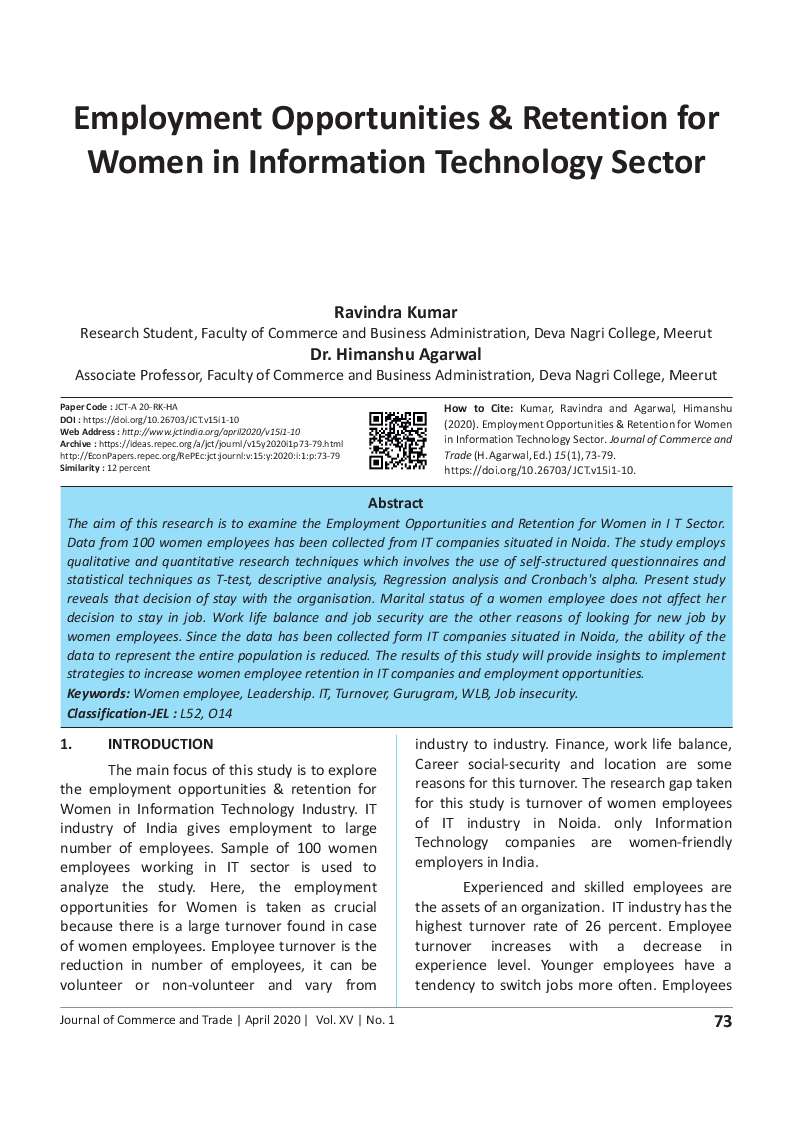Employment Opportunities & Retention for Women in Information Technology Sector
DOI:
https://doi.org/10.26703/jct.v15i1.56Keywords:
Women Employee, Leadership, WLB, Information TechnologyAbstract
The aim of this research is to examine the Employment Opportunities and Retention for Women in I T Sector. Data from 100 women employees has been collected from IT companies situated in Noida. The study employs qualitative and quantitative research techniques which involves the use of self-structured questionnaires and statistical techniques as T-test, descriptive analysis, Regression analysis and Cronbach's alpha. Present study reveals that decision of stay with the organisation. Marital status of a women employee does not affect her decision to stay in job. Work life balance and job security are the other reasons of looking for new job by women employees. Since the data has been collected form IT companies situated in Noida, the ability of the data to represent the entire population is reduced. The results of this study will provide insights to implement strategies to increase women employee retention in IT companies and employment opportunities.
Classification-JEL : L52, O14
Downloads
References
Ashcraft. C.. Mclain. B. and Eger. E. (2016). Women in Tech: The Facts (2016 update//see what's changed and what hasn't). Published by NCWIT. Available at https://www.ncwit.org/sites/default/files/resources/ newit Women-in-it 2016-full-report final-web06012016.pdf.
Bhattacharyya. A. and Ghosh. B. N. (2012). "Women in Indian information technology (IT) sector: a sociological analysis”. IOSR Journal of Humanities And Social Science (JHSS). Vol. 3, No. 6. pp.45-52.
Commander. S., Chanda. R., Kangasniemi, M. and Winters. L. A. (2004). "Must skilled migration be a brain drain? Evidence from the Indian software industry". Centre for Economic Policy Research. pp. 1422.
Cronbach. L. J. (1951). "Coefficient alpha and the internal structure of tests", Psychometrika, Vol. 16.
Deepa. ll. and Stella. M., (2012). "Employee turnover in 'IT' industry with special reference to Chennai city.an exploratory study". International Journal of Multidisciplinary Research, Vol. 2. No. 7. pp. 160-171.
Doody. S. P. (2007), High-involvement Work Systems; Their effect on Employee Turnover and Organizational Performance in Neu, Zealand organizations. Lincoln University. 2007.
Gupta. B. (2017). Analytics and Data Science India Employee Attrition Study - 2017. Retrieved March 14.2019.
Human. M. A. and Management. R. (2015). " An Analysis of the Factors Affecting Employee Retention And Turnover in the lrish Hospitality Industry ", National College of Ireland, Ireland. September 2015.
Hewlett, S.A., Buck Luce. C., Servon, L., Sherbin, L., Shiller. P., Sosnovich, E. and Sumberg. K. (2008). "The Athena Factor: Reversing the Brain Drain in Science ", Engineering. and technology. New York: Center Forwork-Life Policy. January 2008.
Mariyappan, M.S. R. and Kumar, C. V (2012), "Women empowerment from Indian IT and lTeS industry", International Journal of Advance Research in Management and Social Science, Vol. 1, No. 4. pp 20-27.
Kaur, S. (2013). “Attrition in India – causes and remedies". International Journal of Emerging Research in Management and Technology, Vol. 9359, No. 26, pp 2278-9359.
Reddy. G A. K. and Srinivasa. M. (2016). "Employee retention strategies in Indian software industry". international Journal of Core Engineering and Management, Vol.2, No. 1, pp 14-24.
Tobergte. D. R. and Curtis. S. (2013). "Turnover intention: an examination of job characteristics and transactional leadership style among operators in electrical and electronics sub-sector". Journal of Chemical information and Modeling, 53 (March), pp. 1689- 1699.
Tseng. C. and Wallace. M. (2009). "Retention of software employees in the IT industry in Taiwan." Proceedings of the Sustainable Management and Marketing; Australian and New Zealand Academy of Management (Anzam) Conference, 17.
Zachariah- M. and Roopa. T. N. (2012), "A study on employee retention factors influencing IT professionals of Indian iT companies and multinational", interdisciplinary. Journal of Contemporary Research in Business, Vol. 4, pp. 449-466.
India Ranks 3rd Lowest in Having Women in Senior Roles: Report. Http://Economictimes. Indiatimes.Com/Jobs/India-Ranks-3rdLowest-In-Having-Women-In-Senior-Roles-Report/Articleshow/ 57540359.Cms
IT. I., Hir, N., Masscom-Mercer, B., Nasscom, B. and Recession. G.E. (2008).

Downloads
Published
Issue
Section
License
Copyright (c) 2020 Ravindra Kumar, Dr. Himanshu Agarwal

This work is licensed under a Creative Commons Attribution 4.0 International License.










